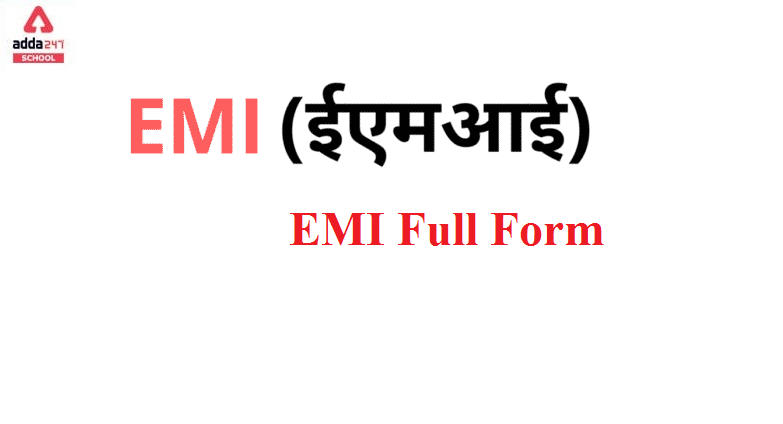EMI Full Form in English
EMI Full Form: The full form of EMI, the abbreviation, stands for Equated Monthly Instalment.
An EMI is a monthly payment made by a borrower to a moneylender. This monthly payment, EMI, is done for a set length of time on a specific day. Equated Monthly Instalment, as the name implies, is a portion of the equally divided monthly outgoings required to pay off an outstanding debt within a set period of time.
An EMI consists of a principal amount and an interest amount. The interest amount is the amount that a borrower must pay back over a set number of years in order to fully repay the loan. As a result, the interest rate and principal are unequally distributed.
The borrower pays fixed periodic payments to the lender over the course of several years in order to pay off the loan under the most prevalent types of loans.
Read About: PVC Full Form
EMI Full Form in Hindi ( EMI ka Full Form )
ईएमआई का पूर्ण रूप, समान मासिक किस्त के लिए है। एक ईएमआई एक उधारकर्ता द्वारा एक साहूकार को एक विशिष्ट दिन पर निर्धारित अवधि के लिए किया गया मासिक भुगतान है। समान मासिक किस्त, जैसा कि नाम का तात्पर्य है, समान रूप से विभाजित मासिक आउटगोइंग का एक हिस्सा है जो एक निर्धारित अवधि के भीतर एक बकाया ऋण का भुगतान करने के लिए आवश्यक है। एक ईएमआई एक मूल राशि और एक ब्याज राशि से बना होता है जो एक उधारकर्ता को ऋण को पूरी तरह से चुकाने के लिए निर्धारित वर्षों में वापस भुगतान करना होगा। नतीजतन, ब्याज दर और मूलधन असमान रूप से वितरित किए जाते हैं।
Read About: CSE Full Form
EMI Full-Form and Important Factors
The EMI is determined by a number of factors, like:
- Interest rate
- The loan’s principal amount
- The resting period (annual or monthly)
- The loan’s duration
Read About: ED Full Form
EMI Full Form & How it works
The EMI for a fixed interest rate loan remains constant throughout the loan’s term, assuming no defaults or partial payments. The EMI is used to pay off both the principal and interest on a loan that is still outstanding. The interest component of the first EMI is the largest, while the principal component is the lowest. With each succeeding EMI, the interest component continues to decrease while the principal component continues to increase. Thus, the final EMI has the largest principal component and the smallest interest component.
If a borrower makes a pre-payment during the term of a current loan, the succeeding EMI is decreased, or the loan’s original term is reduced, or a combination of both. When a borrower skips an EMI during the loan’s tenure (EMI holiday, cheque dishonour/bounce, insufficient balance in case of auto deduction of EMI, or a default), the subsequent EMIs will either increase or the loan’s tenure will increase, or a combination of both, in addition to incurring a financial penalty, if any.
EMI Full Form & Benefits of EMI
EMI allows people to buy exorbitantly costly or at times luxurious things as well. The things that are out of their financial reach by allowing them to pay, buy and own in instalments.
There is no middleman, and that is the reason why people consider it more feasible. People can pay their EMIs directly to the lender and that too without having to deal with a middleman.
Because individuals are forced to pay minimum monthly payments rather than a flat sum, EMI has no influence on their savings.
Read About: SDM Full Form
What is the Full Form of EMI?
EMI can’t be classified as either positive or negative. It depends on the circumstances, such as whether you consider borrowing and accruing debt to be bad, and whether you consider paying for items in full to be a “good” alternative.
However, in terms of financing possibilities, EMI has some advantages. It assists borrowers in budgeting their finances and remembering their outstanding responsibilities because it separates the debt into the same fixed monthly payments. They know how much they owe and how long it will take them to pay it off completely.
| CBSE Full Form | ICSE Full Form |
| CEO Full Form | SOP Full Form |
| AM PM Full Form | ACP Full Form |
EMI Full Form: FAQs
Ques. What is the meaning of EMI?
Ans. The term EMI refers to an equivalent monthly installment. As the name implies, these payments are always the same amount.
Ques. What Is EMI and How Is It Calculated?
Ans. The flat-rate approach and the reducing-balance method are the two methods for calculating EMI. In their computations, both take into account the loan principal, the loan interest rate, and the loan period.
Ques. How Does EMI Work on a Credit Card?
Ans. When you buy something with an EMI option on a credit card, your available credit limit is decreased by the total amount of the products or services.
Ques. What is the formula for EMI?
Ans. EMI is calculated using the following formula: EMI = P r (1 + r)n/((1 + r)n – 1), where P is the loan amount, r is the interest rate, and n is the term in months.
Ques. What exactly is EMI?
Ans. Equated Monthly Installment, as the name implies, is a portion of the equally divided monthly outgoings required to pay off an outstanding loan within a set period of time.









 Try CUET College Predictor 2025 to Predi...
Try CUET College Predictor 2025 to Predi...
 CUET Result 2025 OUT (Today) @cuet.nta.n...
CUET Result 2025 OUT (Today) @cuet.nta.n...
 Why the Delay in CUET UG 2025 Results? C...
Why the Delay in CUET UG 2025 Results? C...









